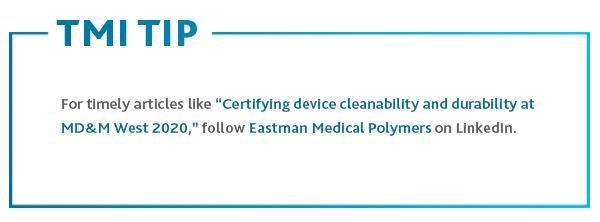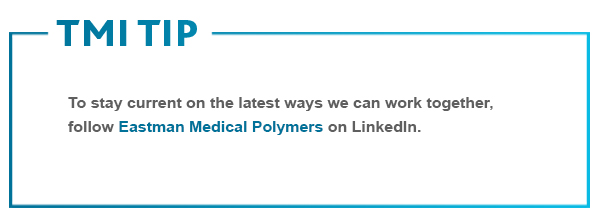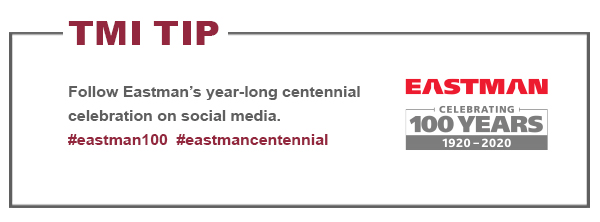14

NOTE: We appreciate you being part of our TritanMoldIt community! To ensure we are covering the information you need to best serve your customers and advance your business, we invite you to fill out this brief survey. As a thank you, you will have the option to be entered in a drawing for an Amazon Echo Show!
In examining why devices fail, it’s crucial to understand what happens when they are exposed to disinfectants and other harsh chemicals during cleaning. Constant exposure to many of these chemicals can damage a device’s structure — causing cracks, crazing, discoloration, and stickiness — and lead to compromised device performance, longevity, and ultimately, safety.
Material choice is a major factor in a device’s success or failure. The reality is that many materials commonly used in medical devices today have a low level of compatibility with current disinfectants and cleaning protocols. Low chemical resistance combined with the high-stress environment of a healthcare setting often lead to device failures.
Infusion pumps are the No. 1 medical device plagued with significant safety issues related to failures. Ivenix, a medical technology company, is dedicated to eliminating infusion-related patient harm. Recognizing the link between chemical resistance, impact, and device failure, Ivenix collaborated with Eastman to select the latest medical housing polymer for its debut infusion pump. The Eastman polymers used to make the Ivenix pump provide excellent chemical resistance and durability to the aggressive disinfectants used for cleaning devices.
Read more about the Eastman and Ivenix collaboration in this blog.
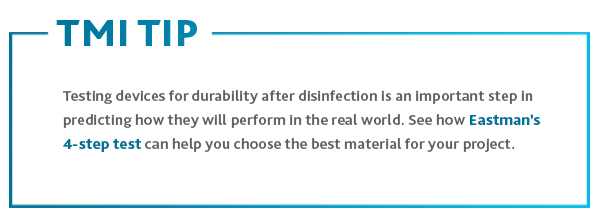
28

NOTE: We appreciate you being part of our TritanMoldIt community! To ensure we are covering the information you need to best serve your customers and advance your business, we invite you to fill out this brief survey. As a thank you, you will have the option to be entered in a drawing for an Amazon Echo Show!
Custom molder Plastic Injection Molding, Inc. (PIM) learned just how easy it was to transition from PC/ABS to Eastman Tritan™ MXF copolyester. PIM made the switch for a project that was initiated by an OEM that furnishes patient-care equipment to hospitals. By converting to Tritan MXF using its existing molds, PIM experienced few processing trade-offs and was able meet the customer’s need for greater chemical resistance to a wider range of disinfectants.
The expanded portfolio of Tritan MXF copolyesters for electronic medical device housings and hardware are specifically designed to withstand the rigors of patient-care hospital equipment. These disinfectant-ready polymers offer a unique blend of processing and performance properties, including clarity, toughness, and heat and chemical resistance. They can also often be substituted into existing molds with minimal adjustments to processing parameters.
Read more about PIM’s experience using Tritan MXF in this Plastics Technology article.
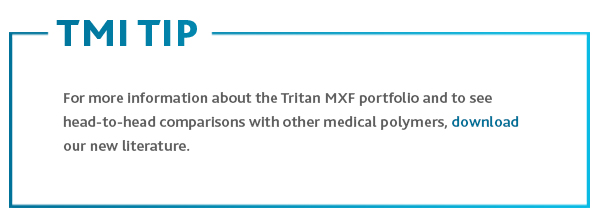
8

NOTE: We appreciate you being part of our TritanMoldIt community! To ensure we are covering the information you need to best serve your customers and advance your business, we invite you to fill out this brief survey. As a thank you, you will have the option to be entered in a drawing for an Amazon Echo Show!
The proper cleaning of equipment has never been more critical. That’s why there has been such a tremendous response to the expanded portfolio of Eastman Tritan™ MXF copolyesters for medical device housings and hardware. (For more information on the challenges facing the medical market, scroll down to the November 22, 2019, blog or check out this webinar.)
When the expanded Eastman MXF portfolio was launched at MD&M West 2020, device makers and molders immediately saw the advantages of the disinfectant-ready polymers, including:
• Measurable and outstanding disinfectant resistance
• Higher flow options to fill complex or existing tooling
• Higher impact strength options for added durability
• Fully compounded, stable colors
• Similar shrinkage to PC/ABS—potential to use existing tools
• UL 94 V-2 flame retardant rating
The portfolio has also received favorable reviews like this from the medical industry media.
Compared to other medical polymers, Tritan MXF copolyesters can reduce repairs, returns, and warranty claims related to breakage and premature failure. MXF polymers can also reduce the need for multiple polymers in an assembly, saving money and providing consistent results.
Best of all, the MXF portfolio lets manufacturers enhance their brand image and customer confidence by translating improved cleanability, durability, and reliability into longer warranties. Case in point: after switching all monitor housings in North America to the MXF portfolio, Mindray was able to extend their warranties from one year to five years.
For more information about the Tritan MXF portfolio and to see head-to-head comparisons with other medical polymers, download our new literature or contact an Eastman customer service representative today.
26

Molders and brand owners come to us for many different reasons during the developmental journey of a medical device.
• You may have a totally new device and want the best-fit polymer to optimize its performance advantages.
• Your current material may not have the chemical resistance and toughness to meet changing hospital disinfectant protocols and more powerful drugs and carrier solvents.
• Recent regulations may be driving the need for more compliant materials.
Whatever the challenge, working with Eastman lets you access technical expertise and support every step of the way—to help position your device for end-state success.
By collaborating early and often during product development and manufacturing, we can help you work with product engineers, toolmakers, and downstream assembly partners to bring your project to market efficiently and profitably.
Here are a few of the benefits of working together with Eastman:
• Design Center expertise—Eastman Design Center engineers can provide mold-filling simulation support as well as stress analysis of the proposed parts.
– This can help reduce problems related to gating, plastic flow path, knit lines, and air traps.
– Early identification allows design changes before tooling to reduce costs and time.
• On-site technical support—Eastman can provide on-site support to help you maintain polymer properties while making the most of your molding conditions. This is especially valuable if you’re not experienced working with our medical copolyesters.
• Post-molding testing—We can offer molecular weight analysis and other post-molding testing of the molded parts to make sure the Eastman copolyester is processing as expected. Ongoing monitoring helps validate performance consistent with that received during qualification.
• Downstream handling advice—Eastman can provide expertise in downstream handling of molded parts, including joining, decorating, and mechanical assembly into your final product.
What challenges are your medical devices facing today—and in the future? Eastman is dedicated to listening to our partners, understanding their unique challenges, and sharing world-class expertise that can impact product safety and success.
Contact an Eastman customer service representative today.
20

Injection molders play a unique role in creating stronger, safer medical devices. Molders often have the best understanding of newer materials—and are in the best position to know which materials to use to optimize the performance of both new and existing designs.
Molders and brand owners typically consider the full range of materials for a totally new product. In addition, brand owners frequently work with molders to optimize an existing device by replacing incumbent materials that have fallen behind the healthcare industry’s need for reliability, regulatory compliance, and chemical resistance to hospital disinfectants and cleaners.
Eastman helps molders and brand owners optimize performance through innovative materials and technical support.
Innovative materials
• The growing portfolio of medical grade Eastman Tritan™ MXF copolyesters offer a wide range of disinfectant-ready polymers for clear and opaque applications.
• Eastman medical grade polymers can optimize performance, simplify processing, and improve patient safety through:
- Superior chemical resistance and impact strength
- Reduced repairs, returns, and warranty claims
- Compliance with specific industry regulations
- Fully compounded one-pellet solutions
- Post-sterilization clarity (transparent formulations)
- Reduced scrap waste
- Excellent characteristics for secondary applications and accelerated aging
- Precise replication of tooling features in the molded parts
• Eastman has robust technical resources to help ensure you’re using the optimal polymer for the application and molding conditions.
• For example:
- Prior to testing and sampling, the Eastman Design Center can review both part and tooling designs.
- Eastman can provide mold-filling simulations to help you evaluate processability of candidate materials.
- Eastman can help identify design changes that can be made prior to cutting/tooling to save prototyping costs and get products to market more efficiently.
- Eastman can provide valuable expertise to help optimize secondary processes.





 Close
Close
